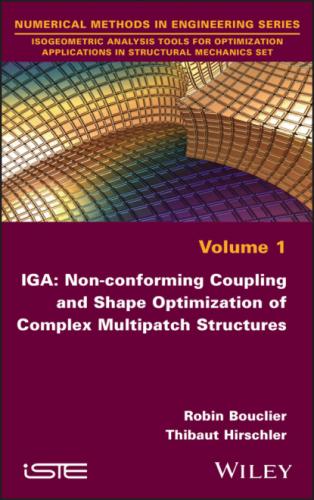where Qi and
[1.30]
where Di is the matrix that decomposes the curve in multiple Bézier curves, Tt is the matrix that elevates the degree of the Bézier curves (see equation [1.29]) and Sr is the matrix that recomposes the B-spline from the multiple Bézier curves. The matrix Sr can be seen as a least-squares pseudo-inverse of the operator used for knot-insertion in step 1.
The refinement procedures (knot-insertion and degree-elevation) can be combined, which offers great flexibility regarding the parameterization of a B-spline curve. In particular, it enables us to introduce a new refinement scheme in which the polynomial degree and the regularity of the basis functions can be simultaneously increased. In this case, degree-elevation is performed first, and then the new knot values are inserted (with multiplicity one), so that elements are added while ensuring the maximum available regularity of the basis functions at the knots level, namely Cp−1. This refinement procedure is called k-refinement (Cottrell et al. 2007). In this work, unless otherwise stated, we will perform k-refinement to take advantage of the superior properties of splines. Eventually, we can simply denote by D the refinement matrix, independent of the refinement procedure. Let us also mention that the same refinement operators can be used for NURBS curves by using the homogeneous coordinates, i.e.:
[1.31]
where xw has one more component than x for each control point: considering Pi = (xi, yi, zi) with associated weight
NOTE.– If the B-spline and NURBS technologies offer new opportunities with the k-refinement process, it has to be noted that multivariate B-spline or NURBS bases do not provide a natural possibility for local mesh refinement. Again, the reason for this is the rigid tensor-product structure [1.18] of these functions that precludes local mesh refinement within a patch. The possible harmful effects of a tensor product structure have already been underlined in Figure 1.8 (bottom). Basically, two approaches exist to answer this issue: (i) the generation and coupling of (usually non-conforming) spline patches and (ii) the creation of alternative splines that enable local mesh refinement. In this book, and particularly in Chapter 2, we will contribute to approach (i) in order to perform local mesh refinement and incorporate more general local phenomena within a B-spline or NURBS model. Regarding approach (ii), we may cite, for example, the hierarchical B-splines and NURBS (Vuong et al. 2011; Scott et al. 2014; Hennig et al. 2016), the locally refined B-splines (Dokken et al. 2013), the T-splines (Bazilevs et al. 2010; Scott et al. 2012; Veiga et al. 2012) and the hierarchical T-splines (Evans et al. 2015; Chen and Borst 2018). Among these strategies, T-splines have gathered an important momentum since they are also suitable for addressing trimmed multipatch geometries (see the discussion in section 1.4.1). Nevertheless, if we seek to perform local mesh refinement only, the hierarchical splines may be easier to implement (D’Angella et al. 2018). Finally, note that the work on new splines is by no means complete, as demonstrated, for example, by the recent introduction of U-splines (unstructured splines) by Coreform for industrial applications (Thomas et al. 2018).
1.2.3.2. Geometric modification
As stated previously, B-splines and NURBS give the designer great flexibility over the shape. We have already observed the influence of the knot values (see Figure 1.4) and the influence of the weights (see Figure 1.7). The designer can also operate smooth shape changes by modifying the coordinates of the control points, as shown in Figure 1.12. This possibility will be of great interest when performing shape optimization. The design variables could be the spatial location of the control points of the spline entities, which, given the high degree of regularity of spline functions, will enable us to get a light and smooth parameterization of the geometry and of its update. This point will be discussed further in Chapter 4.
Modification 2
Figure 1.12. Example of shape modification by altering the spatial location of the control points
1.2.4. Spline-based finite element analysis: isogeometric principle
1.2.4.1. General idea
The main idea behind IGA is to use the spline-based parameterizations discussed above to build the approximation subspaces when applying Galerkin’s method for solving partial differential equations (Hughes et al. 2005; Cottrell et al. 2009). In this framework, the method can be viewed as a generalization of the FEM that considers smooth and higher-degree functions to replace typical Lagrange polynomials in the computations. Within this work, we recall that only NURBS (which constitute the most commonly used technology in CAD) and simpler B-splines are considered. In the end, this is the only major difference with the classical FEM, from an analytical point of view. IGA relies on the same variational formulations as standard FEM. When invoking the isoparametric element concept, the spline basis turns these weak forms into systems of algebraic equations. In solid mechanics, it means that the displacement field is approximated as:
[1.32]
where Ri are the spline basis functions originated from the considered geometric model of the structure (see equation [1.23]). With this numerical approximation in hand, the principle of virtual work gives the following well-known linear system:
where K is the so-called stiffness matrix, u is the displacement vector (vector collecting the degrees
